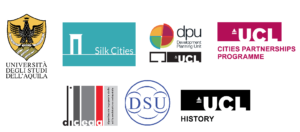
Guest Speakers
Invited academics and practitioners will share their knowledge and experience with the conference participants.
Dr Florian Mussgnug
SELCS, UCL
Writing for a Broken World: Literature and Catastrophe in the Twenty-First Century
The opening decades of the Twenty-First Century have witnessed an unprecedented surge of apocalypse fiction, a genre that is perhaps best understood as an ongoing exploration of what will remain, or what ought to remain, of homo sapiens after a global catastrophe. Climate change, resource depletion and social collapse are just some of the terrifying scenarios that are endlessly replayed in these narratives. My lecture maps this growing interest in narratives of emergency, and focuses on survival in a damaged world. Drawing from twenty-first century literature in English, German and Italian, I argue that apocalyptic thinking plays a key role in contemporary conceptions of human vulnerability, shaping pervasive stories and values. I will specifically refer to three broad, cross-disciplinary concepts: revelation, resilience and radical hope, and will argue that each term corresponds to a different social and political conception of apocalypse fiction: as an articulation of anxious paralysis, a site of progressive activism and a means to building more liveable futures.
Architetto Alessandra Vittorini
Ministero dei beni e delle attività culturali
Superintendent for Archaeological, Artistic and Architectural Heritage and Landscape for L’Aquila and its Seismic Crater, architect with a Phd in Urban Planning, has done research, exhibitions, conferences and publications on architecture, urban planning and restoration, in Italy and abroad. MIBAC architect since 1990, she became Superintendent in 2012, mainly involved in cultural heritage restoration and landscape conservation after the 2009 earthquake in L'Aquila. She directed the Superintendence's team in charge of the restoration of the Collemaggio Basilica in L'Aquila, completed in 2017, and has presented the 2009 post seismic reconstruction of cultural heritage in several conferences and meetings in Italy and abroad (Paris 2016, Istanbul 2016, Cambridge 2017, Fabriano XIII Meeting UNESCO Creative Cities 2019).
Abstract
The post-earthquake reconstruction of L’Aquila represents an extraordinary experience of management, protection and restoration of cultural heritage, fully supported by public funds. This process was further complicated from 2016, by the subsequent earthquakes which devastated Amatrice and a large part of Central Italy, not far from L'Aquila.
The definition of the governance and the legal framework of the reconstruction, the challenging tasks of restoring cultural heritage and the planning and technical-economic evaluations of interventions, are some of the main topics managed in the integrated approach assigned to the Superintendence for L'Aquila and its Seismic Crater, the first such Superintendence in Italy with combined powers in monumental, historical, artistic, archaeological and landscape fields.
This has given us an extraordinary overview of a complex process, due to the importance of the cultural heritage, the severity of the damage, and the solutions found. It has also been a very strong opportunity for study, research and scientific discussion on the post-earthquake recovery of cultural heritage. The most interesting case - for us and for the whole reconstruction - has been the coordination of the largest privately funded intervention in L'Aquila: the restoration of the Basilica of S. Maria di Collemaggio, site of the Perdonanza Celestiniana.
The achievements of our work in this ten-year reconstruction have been presented at several scientific meetings in Italy and abroad, with the aim of sharing experiences and best practices, to make these available to the scientific community and to the decision makers in Italy and in Europe.
It is an engagement that forces us to face different difficulties in order to ensure safety, urban regeneration, structural and technological improvement, energy efficiency, landscape protection and, especially, good and proper use of the restoration methodology.
As 2016 ICOMOS Post trauma reconstruction Colloquium declared, in the face of destruction many issues need our attention: identity, memory, tradition and innovation. Therefore reconstruction means also creating new identities and new relationships. And must focus on rebuilding not only stones, houses and cities, but also the connections between people, spaces and relationships. This is a process that needs the contribution of all the players in the game and that can proceed only with a shared commitment to common goals: giving back to every city its people, and at the same time, giving back each community to its identity and its history. Back to its memory and, finally, back to its future.
Prof. Mauro Dolce
Director General at the Italian Department of Civil Protection
Professor of Structural Engineering, University of Naples Federico II
